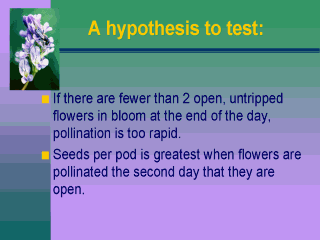
 
 
 

Click any image in the slide to see a larger version.
Scroll down to read accompanying notes. |
 |
Slide 12 of 17
Notes:

As a hypothesis to be tested I propose that if all of the flowers on racemes
are either tripped, wilted, or buds at the end of the day, then pollination
may be occurring too fast. This means that the bees are pollinating every
flower the day it comes into bloom. There is evidence* that
seeds per pod is
greatest when the flowers are pollinated the second day that they are open,
perhaps because the stigma is more receptive on day 2 of bloom. Thus, it is
better for seed set if some flowers are left unpollinated until the second day
of bloom. Furthermore, if all flowers are pollinated on the day that they
open, the bees may run out of food too fast to produce a sustainable
population. Nectar has a chance to accumulate in the flower if it is open at
least 24 hours, so there are more resources for the bee if not all the flowers
are pollinated the day that they open.
* Personal observation. See also:
Carlson, JW. 1928. Seasonal behavior of alfalfa flowers as related to seed
production. J. Amer. Soc. Agron. 20:542-556.
Hanson, C.H. 1961.
Longevity of pollen and ovaries of alfalfa. Crop Sci. 1:114-116.










![]()